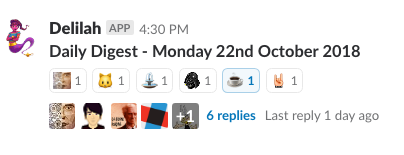Latest news about Bitcoin and all cryptocurrencies. Your daily crypto news habit.
Asynchronous stand ups — one path to improve focus and collaboration
 Photo by Bruno Aguirre on Unsplash
Photo by Bruno Aguirre on Unsplash
Introduction
Have you ever spent time in a stand up that just doesn’t seem to meet the ‘short and to the point’ objective? As the stand up limps into a second hour it seems more like a ceremony to celebrate endurance than a chance to check-in, connect and calibrate.
Your mind wanders, you shuffle awkwardly from foot to foot, you fade in and out of caring and context and wonder if there is a better way, one which saves on shoe leather and stamina.
We wondered the same. With a product owner back from parental leave and working two days in the office and one from home and another team member taking on primary caring duties on a Friday we wondered how we could be more inclusive. How might we find a practice of daily collaboration that everyone could be involved with whether they were in or out of the office. We tried calling the one person who wasn’t in the office but the technology got in the way; poor phone signals and people constantly wondering if someone else was about to speak didn’t lead to great flow.
First attempt — firing off updates into the echo chamber
These stilted stand ups weren’t really working for anyone and so we wondered what else we could try. The team discussed options to improve the inclusivity and landed on doing an asynchronous offline stand up using Slack. Slack is already a deeply embedded collaboration and communication tool within the technology department so there was little friction in uptake.
As with many first attempts there was a lot of trial and error, mild confusion and rising panic as you question whether you are doing the right thing. These feelings were at least leavened with positivity and a willingness to try. The agreements were loose and somewhat flimsy, like a serviette absentmindedly shoved under a saucer that’s suddenly picked up and discarded by a strong gust of wind. Updates were made in different channels, some people threaded, some people responded, others did neither and forgot to put in their updates. There was also reliance on a human to start a thread to trigger people’s memories to post an update. Many days there was no engagement and it became like firing updates off into an echo chamber.
Inspection and adaptation opens an avenue to awesomeness
The first retro after trialling for two weeks generated valuable insights and discussions as we teased out what was and wasn’t working.
The team were universally loving the fact that stand up doesn’t break their maker’s schedule. People get in early and don’t have their concentration and focus broken by stand up and also people don’t have to alter their personal schedule to make sure they arrive in time for stand up. There is also far more flexibility in what time of day a team member collects their thoughts and commits them.
There was unfortunately a level of confusion around the exact process: how, what, when and where to post was not universally understood. As people were not consistently threading it was hard to keep track of updates especially as they were mixed in with the usual team discussions, online collaboration and jokes. People were also naming their updates differently which added to the confusion. There was also a feeling that the level of swarming on issues was lower as there wasn’t the trigger point you get in a stand up when someone calls out that they are stuck, an issue is gaining urgency or that they would like to pair on design / coding to get all the associated benefits. Most importantly the practice didn’t have a name and after some deliberation the team landed on Daily Digest.
Second attempt — Digesting daily
Actions from the retrospective added several more agreements for the next sprint:
- A new channel to be created that would only contain daily updates
- Use a thread for each day
- Thread to be created by 4.30pm and all to complete updates by 9.15am (the time of the in-person stand up)
- Name your updates with explicit days of the week (Mon/Tue rather than yesterday/today)
- Once you have read each update respond underneath with your chosen emoji.
The channel and the threads helped organisation and daily flow while people responding with emojis added some life, colour and interaction to the updates. People now knew that others were reading what they were putting out into the world.
Take three — mob rules — automate all the things
We had some momentum and positive vibes but were still reliant on a human to start the process each day. The team suggested mob programming to create a Slackbot which would create a new thread each day. Welcome to the world Delilah, the digest bot. Now each day at 4.30pm a new thread is created with the day of the week all ready to be filled with goodness from the team.
(Un)intended consequences and adjacent advantages
The asynchronous aspect reduces long contextual or design discussions that unintentionally used to occur in off lines, trapping team members who had little to contribute but are too polite to leave the conversation. Now there are more focused discussions taking place with just the people who can add value or need to be consulted. It seems to have created the space that collaboration happens across the day, not just off the back of the stand up.
There is a written history which can be searched and consulted. When people on the team return from leave all they have to do is browse through the digest to easily gather context and catch up on the progress and challenges the team have been through in their absence. This was not possible with the synchronous stand up. Some team members have reported that writing down the tasks they are going to do and committing them down has helped them structure their day better.
It is easier to pick out when team members are stuck — when updates start reading like last week’s news it stands out, making the team much quicker to call out and collaborate than in the stand up. It’s like watching sports in slow motion; it’s easier to pick out the move and better anticipate what is going to happen, or in this case what is not going to happen.
As we are now tracking work digitally, measurement can happen and correlations can be formed which has led to more informed investment decisions being made both individually and at a team level.
The team are also increasingly comfortable sharing everything they are working on so transparency has increased. There was no mechanism or space in the daily stand up to share broader aspects of what people were working on or spending time investigating. The team have organically been sharing the side projects, engineering work and learning that is lighting their minds. This has led to a deeper understanding in the team of people’s passions and interests and has led to more sharing and conversation. It has also given the product owner a clearer perspective on everything that the team members are involved in and working on, not just specific cards.
We are still to resolve what to do with the physical board and how to represent the longer term focuses and experiments that are not actively worked on but still being observed. Future retrospectives will help us close this loop.
In the meantime the team have agreed to continue with their daily digest as they enjoy the benefits of an async stand up.
Sit down, don’t stand up — one path to improve focus and collaboration was originally published in Hacker Noon on Medium, where people are continuing the conversation by highlighting and responding to this story.
Disclaimer
The views and opinions expressed in this article are solely those of the authors and do not reflect the views of Bitcoin Insider. Every investment and trading move involves risk - this is especially true for cryptocurrencies given their volatility. We strongly advise our readers to conduct their own research when making a decision.
